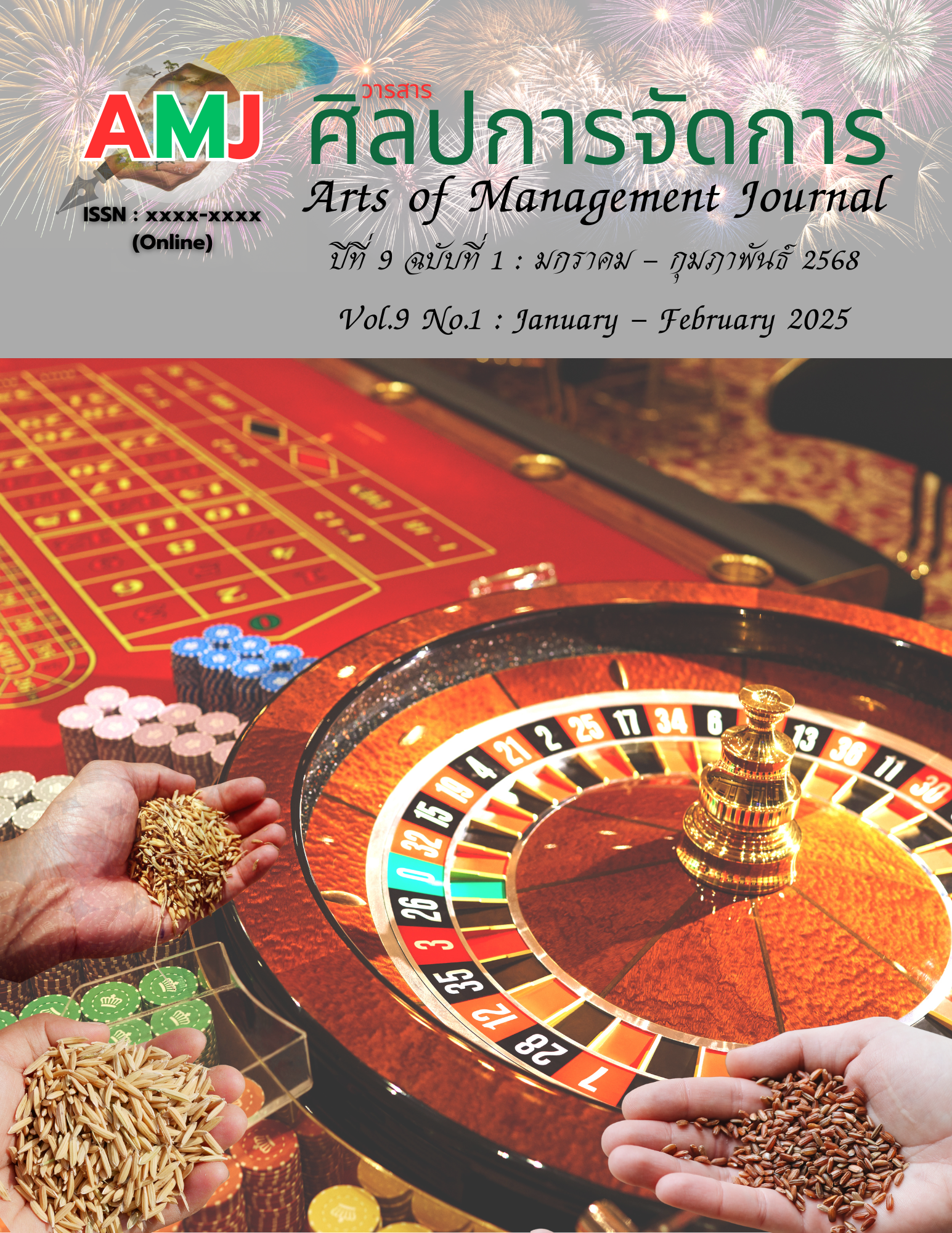Study of Agricultural Waste Materials in Hua Sai District Nakhon Si Thammarat Province to Develop a Reuse Approach
Main Article Content
Abstract
This research aims to 1) study the types, physical characteristics, quantity, and management methods of agricultural waste in Hua Sai, Nakhon Si Thammarat Province, and 2) analyze the weaknesses, strengths, obstacles, and opportunities of agricultural waste to determine its potential for reuse. The findings showed that the majority of participants were male (83.88 percent), aged 40-49 years (33.33 percent), with an educational level below a bachelor's degree (53.33 percent), earning an income of 10,000-20,000 THB per month (30.00 percent), and primarily working as a farmer (53.33 percent). The most common type of waste was goat manure, classified as wet waste with an average volume of 26-30 (tons/year). The study suggested that agricultural waste should be managed by repurposing it for other uses. The analysis of weaknesses, strengths, and obstacles of agricultural waste showed that weaknesses: improper management of agricultural waste, resulting in a source of disease accumulation; strengths: goat manure waste can be processed into compressed charcoal and organic fertilizers; obstacles: consumers lacked proper knowledge and attitudes toward managing agricultural waste effectively, opportunities: identifying policies to promote environmentally friendly consumption and creating a circular system for repurposing agricultural waste for effective reuse.
Article Details

This work is licensed under a Creative Commons Attribution-NonCommercial-NoDerivatives 4.0 International License.
Views and opinions appearing in articles in the Journal of Arts of Management It is the responsibility of the author of the article. and does not constitute the view and responsibility of the editorial team I agree that the article is copyright of the Arts and Management Journal.
References
Hangsoongnern, T., Angkasith, P., Opatpatanakit, A., & Sirisunyluck, R. (2014). Organic farming in the context of sufficiency economy: case study of organic farmers in Mae Rim Watershed, Chiang Mai Province. Journal of Agriculture, 30(1), 61-69.
Jaitae, S. (2013). Development of healthy home garden vegetable production at Saluang Keelek community, Maerim district, Chiang Mai province. Rajabhat Chang Mai Research Journal, 14(2), 15-22.
Jaitae, S. (2021). Agricultural residues utilization among farmers in Keelek Sub-district Municipality Mae Rim District, Chiang Mai. Journal of Agri. Research & Extension, 38(2), 79-88. https://li01.tci-thaijo.org/index.php/MJUJN/article/view/234955
Laead-on, K., & Lomarak, T. (2020). Utilization from agricultural waste material in local for straw mushroom cultivation material. Journal of Agricultural Research and Extension, 38(2), 68-78. https://li01.tci-thaijo.org/index.php/MJUJN/article/view/224282
Nigussie, A., Kuyper, T.W., & de Neergaard, A. (2015). Agricultural waste utilization strategies and demand for urban waste compost: evidence from smallholder farmers in Ethiopia. Waste Management, 44, 82-93. https://doi.org/10.1016/j.wasman.2015.07.038
Nithichaowakul, T. (2019). Marketing management: teaching documents. Faculty of Management and Tourism, Burapha University.
Oladipo, F.O., Olorunfemi, O.D., Adetoro, O.D., & Oladele, T.O. (2017). Farm waste utilization among farmers in Irepodun local government area, Kwara State, Nigeria: implication for extension education service delivery. Ruhuna Journal of Science, 8, 1-11. DOI:10.4038/rjs.v8i1.22
Omanee, S. (2016). Evaluation of meat goat raising system and marketing channel a case study in Surat Thani Province[Master’s thesis, Prince of Songkla University].
Promsaka Na Sakolnakorn, T., & Leknoi, U. (2021). Community waste management under the circular economy concept of local administrative organizations. Humanities and Social Sciences Journal of Pibulsongkram Rajabhat University, 15(2), 362–373. https://doi.org/10.14456/psruhss.2021.28
Rojthangkham, T. (2020). The public participation in the control of agricultural residues burning regulation. Journal of the Ombudsman, 13(1), 37–56. https://so04.tci-thaijo.org/index.php/ombudsman/article/view/214831
Saisana, C. (2021). Zero-waste management of Koh Kok community using the principles of circular economy[Master’s thesis, National Institute of Development Administration].
Sriwan, K. et al. (2023). A study of the problems and needs of goat raising under the commercial goat raising promotion project in the area of 5 southern border provinces. In Research paper presented at the 4th Hat Yai Academic Conference, May 10.
Suwunniponth, W. (2021). Competitiveness based on the digital economy among community enterprises of local product groups in Bangkok. Research and Development Journal Suan Sunandha Rajabhat University, 13(1), 1-21.
Tengkaew, S., & Wiwattanadate, D. (2014). Study of source and potential of biomass from field corn in Thailand. Prince of Naradhiwas University Journal, 6(3), 102-111. https://li01.tci-thaijo.org/index.php/pnujr/article/view/53881
Wongsuwan, S., Khiaomang, K., & Seo, M. (2020). Study of physical properties of agricultural waste materials for handicraft industry, Ban Tham Suea community. Phetchaburi Province. RMUTP Research Journal Sciences and Technology, 14(2), 31-44.


